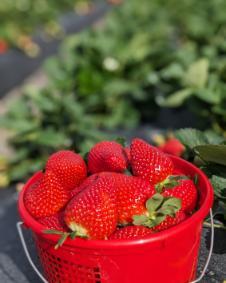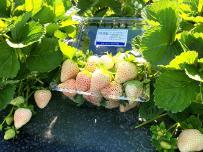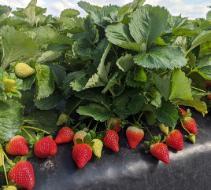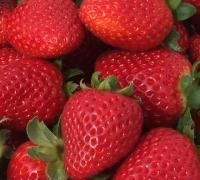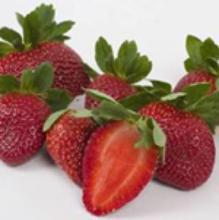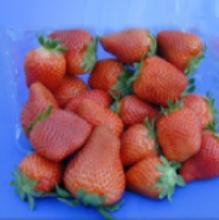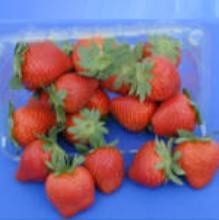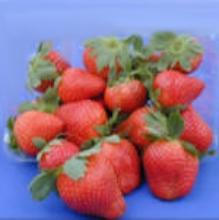UF/IFAS Strawberry Varieties
UF/IFAS strawberry cultivars are bred to have the yield, fruit quality and disease resistance that Florida growers need.
Below is a link to video presentations explaining how the breeding program works.
The Strawberry Clean Plant Program
About the UF/IFAS Strawberry Breeding Program
| Photo | Description |
|---|---|
|
Florida Ember® ‘FL 20.80-4’ |
Ember® is named for its bright red external fruit color. It has excellent overall fruit quality, in particular the unusual combination of a high degree of rain resistance combined with excellent sweetness and flavor similar to Florida Medallion™. It has an excellent overall disease resistance package. In particular this cultivar is less susceptible to Neopestalotiopsis spp. than other current varieties from the UF program, particularly with regard to disease on the fruit. It has excellent early yields and is well-suited to planting during the early half of the planting window in Florida, from Oct 1 to Oct 15. This variety is best suited to open field production and has not yielded as well in high-tunnel environments. |
|
Florida Encore® ‘FL 20.34-183’ |
Encore® is so named because it is considered an improved version or “encore” of ‘Florida Brilliance’, which is a grandparent of this cultivar. It has a robust plant that is easy to grow and is well-suited for the most sandy soils in central Florida. It works well when planted in the second half of the Florida planting window, between Oct 10 and 20. It has high early yields with a heavy fruit load on the first inflorescence. It exhibits better tip pollination and larger fruit size than ‘Florida Brilliance’. It also possesses a reflexed calyx that curves away from the shoulder of the fruit, reducing the development of Botrytis. It has moderate resistance to Phytophthora cactorum. |
|
Florida Pearl® ‘FL 18.52-66’ |
The Pearl® 66 is the second white strawberry release from our program, following the original Pearl® 109. It has improved agronomic and yield characteristics for Florida open field production including higher early yields, improved fruit firmness, more consistent fruit size, and more compact plant habit. The fruit are also more intensely flavored with both higher sugars and higher acids. It has excellent overall disease resistance with at least moderate resistance to most diseases. |
 Florida Felicity™ ‘FL 17.15-86’ |
Felicity™ is a short-day variety released for high tunnel production in the Mediterranean basin that is also adapted to other winter and spring production regions. Due to its excellent pollination and yields it is also a good choice in other protected culture environments such as greenhouses. It has extremely consistent fruit shape and pollination similar to ‘Florida Beauty’ but with higher yield and larger fruit size. The fruit have rich red color, high brix and a nice balance of sweetness and tartness. The plants are vigorous and robust and are moderately resistant to crown and roots rots caused by Phytophthora cactorum.
|
|
Florida Medallion™ ‘FL 16.30-128’ |
Medallion™ is a short-day variety that is distinctive for its intense flavor, the best yet of any UF/IFAS strawberry variety. It also has extremely consistent conical shape and size as pictured above. These characteristics along with its medium red color, gloss and firmness make it a great choice for high quality markets. It has a compact and upright plant that allows for easy harvest of the fruit but requires higher fertilization rates to achieve optimum yield when compared to ‘Florida Brilliance’ and Sweet Sensation® ‘Florida127’. It also produces fewer runners in the fruiting field and the nursery than these standard varieties.
|
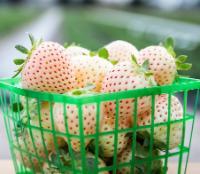 Florida Pearl™ ‘FL 16.78-109’ |
Pearl™ is the first white-fruited strawberry or “pineberry” released by UF/IFAS and is the first pineberry to be distributed widely in supermarkets around United States. It is the result of hybridization between descendants of Japanese white strawberries, the source of its unique color, and red Florida strawberries, the source of its yield, disease resistance and other commercial production qualities. It has a pure white internal color and a white external base color with red seeds and a pink blush when ripe. It has a distinctive low-acid flavor and often has aromatic notes similar to pineapple or apricot. The plant is robust and easy to grow and has moderate resistance to most diseases. Video PresentationFSGA Strawberry Varieties Presentation Pearl Technical Video |
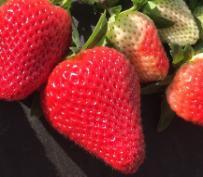 ‘Florida Brilliance’ |
‘Florida Brilliance’ is so named for its attractively glossy and conical fruit. The fruit are also very firm with excellent shelf life, juicy texture and bright flavor. Its early yields are the highest among the University of Florida short-day cultivars. It is also efficient to harvest due to its open yet robust plant and long stems. The plant will not require as much early-season nitrogen for plant establishment as for ‘Florida Beauty’ and ‘Florida Radiance’ (Florida Fortuna). It has moderate to high resistance to most diseases but is susceptible to crown rots caused by Phytophthora cactorum. |
|
'Florida Beauty' |
‘Florida Beauty’ is distinct for its day-neutral flowering habit, low chill requirement and compact plant, making it ideal for early planting (Sept 20 – Oct 1) in West-Central Florida. The fruit have excellent rain tolerance, very consistent shape and color, and very good flavor. Fruit of this cultivar have sufficient quality to be marketed at retail under the Sweet Sensation® brand if desired. It is resistant to Phytophthora crown rot but is susceptible to powdery mildew and anthracnose fruit and crown rots. |
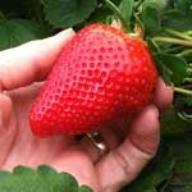 Sweet Sensation(R) |
Sweet Sensation® is distinctive for its combination of high early and total yields, large fruit size and excellent fruit quality due to high sugars, fruity aroma, firm but juicy texture and extended shelf life. The external color of the fruit is light red, similar to the fruit color of Winterstar™. The plant is upright and moderately vigorous, and planting dates and fertilization rates should be adjusted accordingly. This cultivar is resistant to anthracnose fruit rot and moderately resistant to charcoal rot and Colletotrichum crown rot but is susceptible to Botrytis fruit rot, powdery mildew and Phytophthora root rot. |
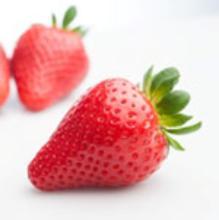 Winterstar(TM) |
Winterstar™ may be the earliest strawberry variety released from the UF breeding program, with slightly earlier bearing in Florida compared to ‘Florida Radiance’. It also has a more sturdy plant habit that ‘Florida Radiance’. This cultivar has exceptionally uniform fruit in Florida production which are quite firm. The fruit do not darken significantly in the cooler, maintaining bright color. The fruit also have a sweet flavor due to low acids. This genotype is moderately resistant to anthracnose fruit rot, charcoal rot, and Colletotrichum crown rot but is susceptible to Botrytis fruit rot and Phytophthora root rot. |
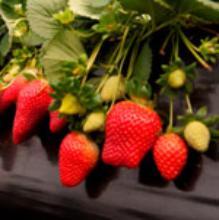 'Florida Radiance' |
This strawberry genotype is named ‘Florida Radiance’ because of the attractive luster of its fruit. ‘Florida Radiance’ has a more open-plant habit than ‘Strawberry Festival’ which, along with fruit that are attached to long pedicels, makes the plant easy to harvest. In recent studies, ‘Florida Radiance’ has produced higher yields than ‘Strawberry Festival’ in February. ‘Florida Radiance’ has maintained good fruit size throughout the main production period in plots at the University of Florida, and on several commercial farms in west-central Florida and southwest Spain. ‘Florida Radiance’ is moderately resistant to Colletotrichum crown rot and anthracnose fruit rots but is moderately susceptible to Botrytis fruit rot and is highly susceptible to Phytophthora root rot. |
 'Florida Elyana' |
‘Florida Elyana’ strawberry has produced large, flavorful fruit from December through March in experimental plots and in a high-tunnel trial on a commercial farm in western portions of Central Florida. This cultivar has also shown promise in high and low-tunnel trials on commercial farms in Spain, Morocco, and Egypt. ‘Florida Elyana’ is smaller and also a lower-stature plant than ‘Strawberry Festival’. The habit of ‘Florida Elyana’, along with fruit that are attached to long pedicels, makes the plant easy to harvest. This cultivar is recommended for trial in areas of winter and spring production where strawberries are grown in tunnels or dry environments and is a tough plant moderately to highly resistant to a number of diseases. |
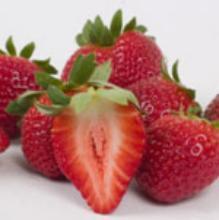 'Winter Dawn' |
‘Winter Dawn’ can produce higher November through February yields (in central Florida) than other cultivars when planted the last week of September or the first week of October. Also, this cultivar can produce relative large fruit on small plants, and like ‘Carmine’ its fruit is resistant to botrytis and anthracnose fruit rots. ‘Winter Dawn’ produces numerous runners (stolons) in the nursery but relatively few runners after being transplanted to the fruiting field. |
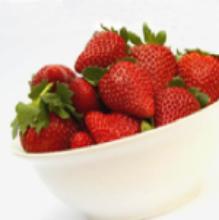 'Rubygem' |
This cultivar is a joint release with Dr. Mark Herrington of Queensland Primary Industries. Primarily grown and sold in Australia, ‘Rubygem’ has an excellent sugar acid balance, which gives it a sweet tasting flavor. ‘Rubygem’ has a moderate level of rain tolerance with skin cracking and etching of the fruit surface around the seeds. In Florida, blotchy ripening can also occur in wet weather if nutritional balance is not correct. This clone was named ‘Rubygem’ for its attractive deep, ruby red color. |
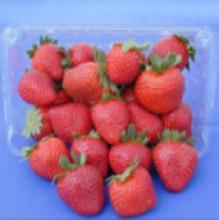 'Carmine' U.S. Patent PP18,261 Released 2002 |
‘Carmine’ can produce high mid-season yields in central Florida. Its fruit contain generous levels of antioxidants. High density plantings of Carmine (up to 33,000 plants per acre) have been successful because of the compact nature of the plant, and the fact that ‘Carmine’ has good resistance to botrytis and anthracnose fruit rots. A compact plant habit and relatively long and stiff pedicels result in many flowers and fruit that are exposed, making the fruit easy to harvest but also vulnerable to rain and freeze damage. This clone was named ‘Carmine’ because of the deep red color of its fruit. |
|
'Strawberry Festival' |
‘Strawberry Festival’ dominated the Florida industry for almost a decade until 2012 and is a grower favorite because it has a sturdy bush that is easy to harvest, doesn’t yield huge quantities of fruit on any one date, and produces very few cull fruit. It is a supermarket favorite because its fruit are attractive, fit well in one pound clamshell containers, and have a long shelf life. The vigorous plant tends to produce sturdy runner plants in the nursery. This clone was named ‘Strawberry Festival’ in recognition of the Florida Strawberry Festival, an annual festival in Plant City that celebrates the abundant crop of berries harvested in eastern Hillsborough County during late February and early March. |
|
'Earlibrite' |
‘Earlibrite’ was released as an alternative to ‘Sweet Charlie’ whose fruit shipment and shelf life were problematic due to its lack of firmness. 'Earlibrite' produces high early-season (December through February) yields of large, flavorful fruit; but it does have a tendency to produce some misshapen fruit. The clone was named 'Earlibrite' because of its high early-season production of bright red fruit, and to honor Earl Albregts, a soil scientist who spent his entire professional career (1967-1996) at GCREC-Dover. |
|
'Rosa Linda' |
‘Rosa Linda’ produces high early season yields of attractive, flavorful fruit, and has moderate resistance to Botrytis fruit rot. Firmness of ‘Rosa Linda’ fruit is only moderate, and this cultivar has a tendency to produce many small berries late in the season. The clone was named Rosa Linda (pretty rose in Spanish) because of the pleasant rose aroma sometimes detected when the fruit is eaten. |
|
'Sweet Charlie' |
Although ‘Sweet Charlie’ is no longer an important cultivar in west central Florida because of the short shelf life of its fruit during warm weather, it can still be useful for strawberry growers in other areas of southeastern U.S who want early, flavorful fruit to sell directly to the consumer. ‘Sweet Charlie’ often produces higher fruit yields from December through February than any other available variety. It was also the only variety adapted to central Florida that was resistant to anthracnose fruit rot at the time of its release. This clone was named in honor of the late Charles (Charlie) Howard, plant pathologist at the University of Florida’s Gulf Coast Research and Education Center from 1967 to 1991. |
| 'Florida Belle' and 'Dover' Released 1975 and 1979 respectively |
Both ‘Florida Belle’ and ‘Dover’ had good resistance to anthracnose and were higher yielding than the California cultivars that were grown in central Florida at the time. However, neither one became a dominant cultivar in the industry because of fruit quality problems. Fruit of ‘Florida Belle’ was prone to bruising and uneven color development. ‘Dover’ had a tendency to produce many small (unmarketable) fruit at the end of its March picking cycle, and its fruit was occasionally perceived by brokers as being too dark. |
| 'Florida Ninety' Released 1952 |
Florida Ninety was introduced in 1952, and quickly became the dominant variety grown in Florida. Its yields were as much as three times higher than those of Missionary, the variety it replaced, and it had a moderately high degree of resistance to crown rot. Florida Ninety remained the standard variety in central Florida until the mid-1960s, at which time it was replaced by ‘Dabreak’, a Louisiana variety susceptible to crown rot, but with better shipping quality than Florida Ninety. |


